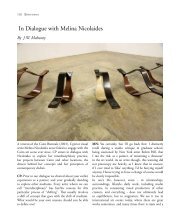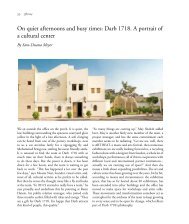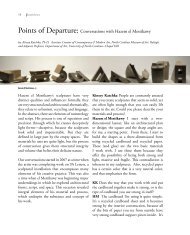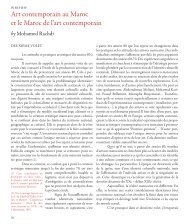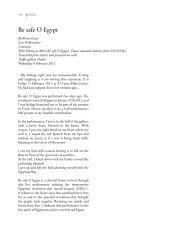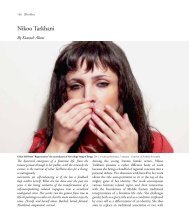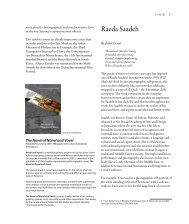full essay - Contemporary Practices
full essay - Contemporary Practices
full essay - Contemporary Practices
- No tags were found...
Create successful ePaper yourself
Turn your PDF publications into a flip-book with our unique Google optimized e-Paper software.
Essay93the artists listed under that category. Nonetheless, a fewexamples in Mahmoud Saïd’s oeuvre prove the existenceof a rich artistic exchange between the painter and hisEgyptian contemporaries. The most obvious appears tobe between him and the other recognized pioneer ofModern Egyptian Art, the Cairene sculptor MahmoudMokhtar. The latter’s oeuvre is very much imprintedby the Egyptian ideology of Neo-Pharaonism in hissubject matter and in the very medium he employed -sculpture. Whether Mokhtar intentionally provoked orpromoted this ‘re-awakening’ of Egypt’s cultural past isdebatable, yet he used it as a means to affirm his ownartistic and national identity. Another reading of hisoeuvre is suggested by Mahmoud Saïd in the very poeticand sentimental letter he wrote in Arabic followingMokhtar’s premature death in 1934. According to thisdocument, Saïd seemed to understand Mokhtar’s artas an expression of the ‘population’s sacrifice for thesake of modernization’ . Saïd praised his friend for thestimulating role he had in the artistic realm of his time,writing that Mokhtar ‘had come in a moment when ourhearts were beating strong and looking into the future’. He perhaps also insinuated Mokhtar’s leading exampleof creating a national Egyptian art, concurrentlyflourishing within Egypt’s politics.Following this deep homage to Mokhtar the year of hisdeath, it is not entirely unexpected to find that Saïd’smasterpiece of Les chadoufs was painted that year, 1934.This work is one of the most deeply rooted in Egyptiansoil, with its predominant earthy colours soaked in awarm Egyptian sunlight. It depicts the hard labour ofthe peasants drawing the water through the ‘chadoufs’to irrigate agricultural land, replicating what theirancestors had been doing for centuries to obtain a richfertile soil. The triangular composition of Les chadoufs,reminiscent of Renaissance perspective, is echoed by theworkers’ loincloths and by the setting’s topology, verypossibly hinting to Egypt’s proud pyramids. The femalefigure in the lower right corner, carrying an amphora onher head, seems to quote Mokhtar’s woman unveilingthe Sphinx in his monumental sculpture Egypt’sAwakening. Focusing on these various elements, Leschadoufs could arguably be described as being oneof Saïd’s most ‘Neo-Pharaonist’ masterpieces, as atribute to his deceased friend. The art of other ModernEgyptian Artists appears to have interacted with Saïd’soeuvre. Mohammed Naghi, a painter also based inAlexandria yet from a different social background, waspart of the same artistic environment. He also studiedart in Europe and obtained a degree in law, yet hisfather pushed him to become an Egyptian diplomat.At the end of the First World War, Naghi visited oneof the pioneers of Impressionism, Claude Monet(1840-1926), in his legendary premises of Giverny.This visual and cultural encounter had an impact onNaghi’s art, as seen in the present work illustrated,exemplifying an interpretation of Monet’s ‘pleinair’method of painting Saïd’s legal and artistic careerdeveloped alongside Naghi’s diplomatic and painter’scareer, bringing them close together within Egypt’sartistic circle. Saïd’s painting El Norag most probablydates from his early years as a painter, revealing his briefencounter with Impressionism. Two care<strong>full</strong>y drawnpreparatory sketches for this painting have survivedand are very academic in their execution, unveiling hisrecent training years in France. The visual similaritiesin terms of subject matter and painterly execution,stylistically leaning towards Impressionism and Post-Impressionism, between El Norag and Naghi’s paintingare undeniable. They show how both started paintingin the same direction and how their social backgroundsand respective careers would later lead them to go onseparate artistic paths. Despite their differences, Naghidefinitively recognized Mahmoud Saïd as a crucialcontributor to the creation of a national identity inModern Egyptian Art. Indeed Naghi depicted Saïd, aswell as Mokhtar, alongside himself and other criticalEgyptian and foreign historical, political and culturalfigures, in his most famous artwork entitled The Schoolof Alexandria (1935-1959), which was unfortunatelyburned in 2011. Mahmoud Saïd was therefore an activeparticipant in the artistic development of his country andthere are other numerous examples of visual dialoguesbetween him and other Modern Egyptian artists suchas Salah Taher, Georges Sabbagh, and Ragheb Ayad.Yet the most ‘Egyptian’ influence in Saïd’s art findsits root in what the painter observed around him. Hepainted more than fifty paintings representing Egyptianlandscapes, out of which more than twenty include theNile. In addition, there are approximately more than



